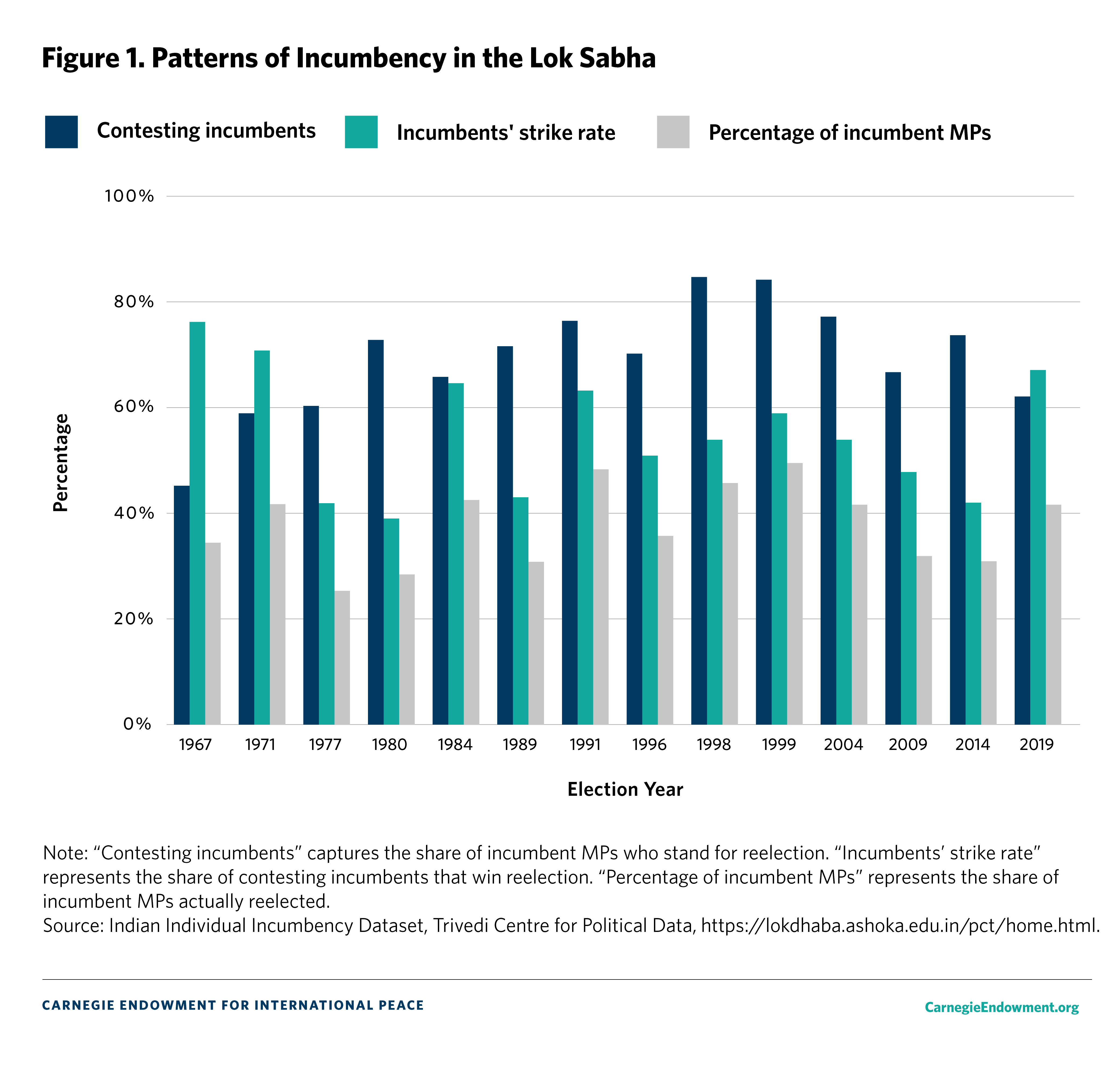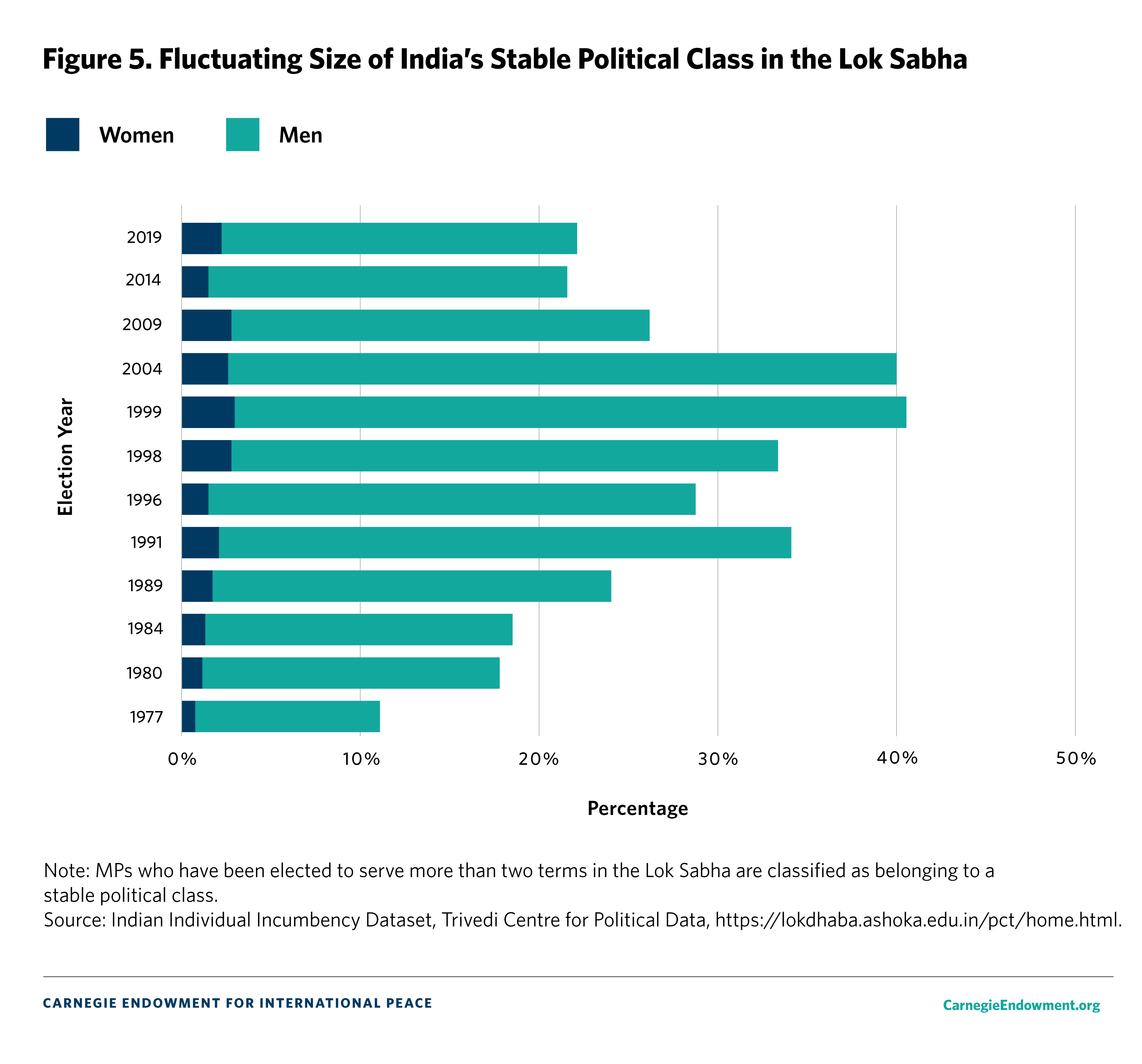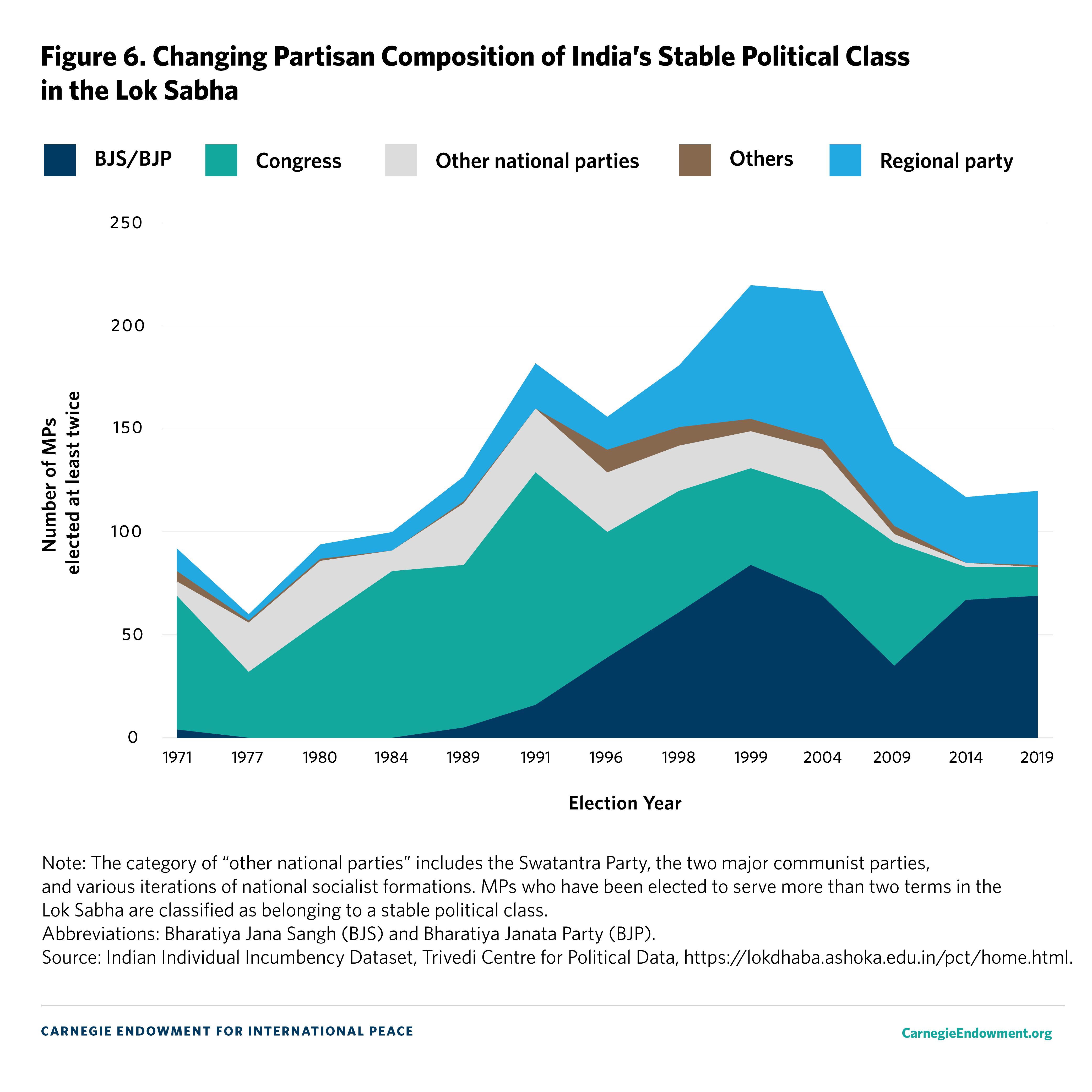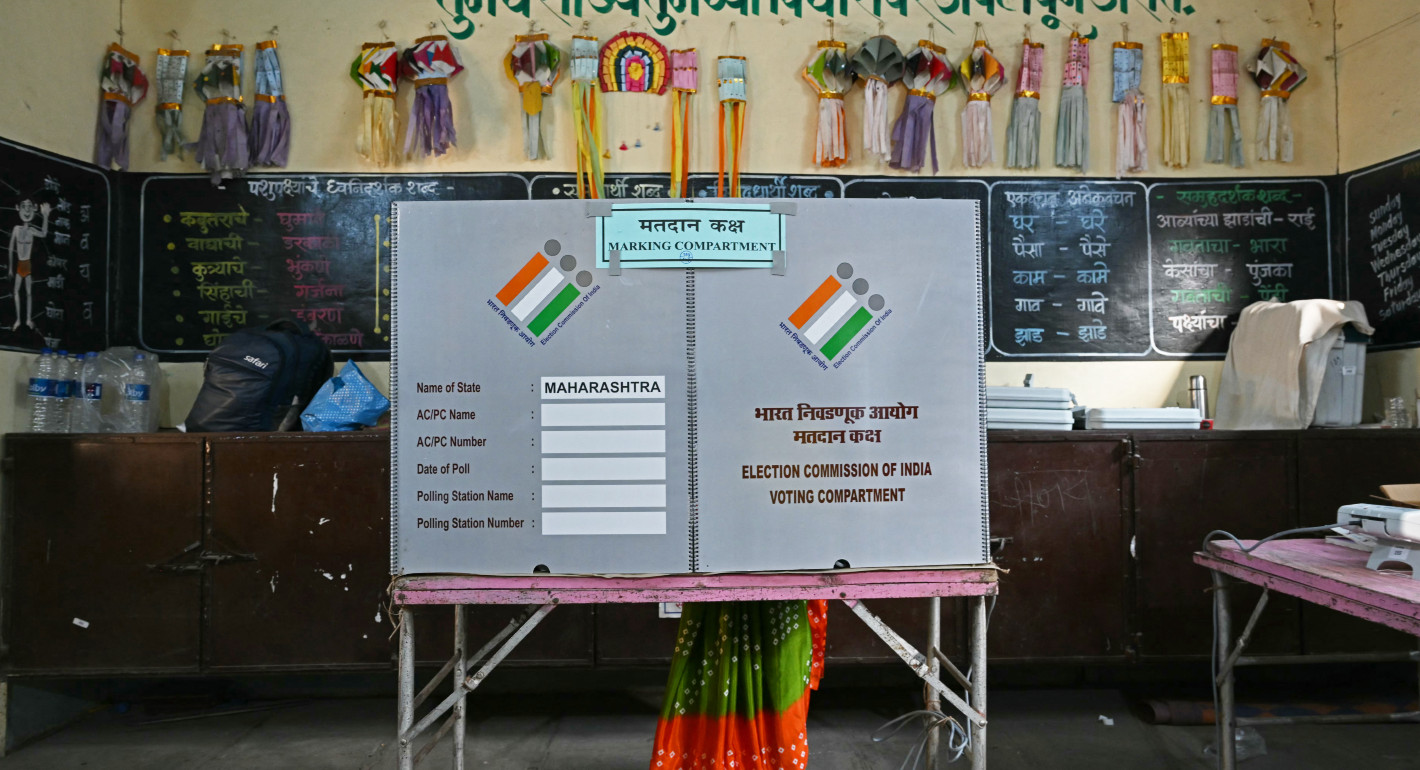In India’s ongoing 2024 general elections, more than 8,000 candidates are competing for 543 seats in the Lok Sabha, the lower house of Parliament. Most of these individuals, including those fielded by major parties, are contesting these seats for the first time.
One cornerstone of India’s electoral politics is the high turnover of elected representatives in both national and regional elections. Contrary to common practice in most democracies, incumbent candidates in India do not benefit from incumbency advantage; in fact, scholars have long spoken of an “incumbency disadvantage” in the Indian context.
In 2019, 226 elected members of Parliament (MPs) were incumbents (41 percent), which is a low figure considering that this election saw the Bharatiya Janata Party (BJP) consolidate the single-party majority it won in 2014, the first in three decades. Only half of the BJP’s MPs (154 out of 303, to be exact) were elected in 2014, and 139 of its 149 nonincumbent MPs were elected to Parliament for the first time. Among the 228 elected opposition MPs, only 67 were incumbents, while 132 were first-time MPs. Additional historical data on individual incumbency coded by the Trivedi Centre for Political Data indicates that this phenomenon is not new. In fact, the share of reelected incumbent MPs was even lower during the first two decades after independence, during the previous era of the Indian National Congress’s (hereafter, the Congress Party) dominance.
The turnover among India’s political class and the declining pool of “stable” political representatives raises important questions about the nature of representation in India and the precise functioning of legislative accountability. This article reviews six decades of data on candidates, nomination patterns, and incumbency to extract broader trends that will not only determine the contours of the 2024 race but also inevitably shape the new Parliament that is formed after June 4.
Dissecting Political Turnover
What explains India’s high rates of political turnover? The following sections utilize data from the Trivedi Centre for Political Data’s Indian Individual Incumbency Dataset, in which a unique identification number was coded for each of the 90,583 candidates who contested general elections in India from 1962 to 2019. This identification number enables the calculation of individual incumbency and career trajectory variables, such as the number of elections contested, terms served, incumbency status, as well as turncoat status of candidates. The data was coded using Surf, an entity mapping and resolution system for Indian names developed by the Trivedi Centre for Political Data’s team.
The first explanation for the high turnover is that not all incumbent MPs rerun in the first place. From 1967 to 2019, fewer than 70 percent of all MPs, on average, reran, and 55 percent of these rerunning MPs got reelected (see figure 1). Therefore, if one does not factor in rerunning rates, the average share of incumbent MPs in the Lok Sabha would stand at a scant 38 percent.1
These figures are relatively consistent over time. The share of rerunning MPs tends to increase when general elections are held in close proximity, as in the 1990s when a series of fractious coalition governments failed to complete their full five-year terms in office. In recent years, the share of rerunning MPs has declined further. In 2019, only 67 percent of all incumbent MPs stood for reelection.

The rate of incumbency varies across parties (see figure 2). For example, the Congress Party tends to retain more of its incumbents than the BJP. On the other hand, regional parties’ renomination strategies tend to fluctuate. In 2014, the ratio of rerunning incumbents was similar across the two national parties and regional parties. In 2019, by contrast, regional parties discarded a majority of their sitting MPs.

There are also regional variations (see figure 3). Some of the largest states—including Karnataka, Maharashtra, Uttar Pradesh, and West Bengal—exhibit a high rate of rerunning incumbents. However, Andhra Pradesh, Odisha, Tamil Nadu, and Telangana saw very few sitting MPs rerunning in 2019. None of Chhattisgarh’s eleven MPs elected in 2019 were incumbents (and ten of them were first-time MPs).
Candidate reshuffling is not a function of electoral competitiveness but of political parties’ distinct organizations, cultures, electoral strategies, and recruitment practices. For instance, the BJP in Gujarat—under Narendra Modi’s leadership as chief minister prior to his ascension to national politics—used to, as a rule, discard 50 percent of their members of the legislative assembly (MLAs) each election.2

Over the last two decades, research by this author has shown that most political parties tend to recruit candidates from similar sociological pools made of self-funded individuals connected to local business networks. As a result, it is easier to discard sitting MPs when they are recruited from outside party organizations. The Bahujan Samaj Party in Uttar Pradesh, which recruits its candidates from locally dominant social groups, is a case in point. “Turncoats,” or party switchers, regularly fielded by parties also reinforce the notion that candidates are interchangeable.
An Assembly of Newcomers
As a result of this high turnover, three-quarters of all MPs elected since 1977 have been either first-time or two-term MPs (see figure 4). While a high turnover of representatives may indicate elite circulation, it also greatly limits cumulative legislative experience among parliamentary representatives. In the 17th Lok Sabha, elected in 2019, only 22 percent of MPs were elected for a third term or higher. These experienced MPs were well distributed across parties and across regions.

During Modi’s tenure as prime minister, the share of experienced MPs has significantly decreased to levels not seen since the 1970s (when then prime minister Indira Gandhi instituted a twenty-one-month state of emergency). This modern-day decrease is unsurprising given that the BJP won many new seats with new candidates over the past two elections. What is more surprising, however, is how few experienced opposition representatives have survived the BJP’s rise. Of the fifty-two Congress Party MPs elected in 2019, only eleven had served in either of the two prior legislatures during the tenure of the Congress Party–led United Progressive Alliance government. Only three—Sonia Gandhi, Rahul Gandhi, and Adhir Ranjan Chowdhury—have consistently served in the Lok Sabha during the last four terms.
Explanations for India’s Political Churn
Why do so few incumbent MPs rerun and get reelected? Three types of explanations account for this phenomenon.
First, political parties have multiple incentives to remove their sitting MPs. For instance, they can field fresh faces as an attempt to buck anti-incumbency. Some parties claim to use the specter of renomination as a reward for high-performing MPs and as a sanction for underperforming MPs. Empirically, however, there is little evidence that performance predicts a legislator’s chances of renomination. More importantly, the threat of non-renomination is an effective instrument to generate and maintain party discipline and to punish faction leaders and their affiliates. Parties may also discard sitting MPs because of alliance arrangements with other parties. If two parties join forces to contest an election, they typically form a seat-sharing arrangement that divvies up seats between them to avoid vote fragmentation.
Second, MPs and candidates themselves can also induce turnover. Some MPs may leave their parties and try their luck with a different party affiliation.3 Other MPs may drop out of the race altogether if they are unable to sustain the cost of remaining in politics or when they find themselves outspent by adversaries. MPs can also choose to shift to a different legislative body, such as a state assembly or the indirectly elected upper house of India’s national parliament (the Rajya Sabha). In the run-up to the 2024 general election, twenty-eight seats sat vacant after officeholders left the lower house for the upper house or passed away so recently that by-elections could not be held on time.
Finally, voters also play a role in ensuring that few sitting MPs get reelected. Across states, the “strike rates” (or the odds of winning reelection) of rerunning MPs are low. In 2009 and 2014, incumbents’ strike rate dropped below 50 percent. On average, since 1977, only 55 percent of rerunning incumbent MPs have been reelected. The propensity of voters to reject incumbents manifests the structural discontent that elected representatives face in India. The author’s repeated interactions with MPs and their state-level counterparts over the years reveal that MPs are expected to respond to endless demands and requests for assistance emanating from their constituencies, using limited resources or infrastructure. When considered alongside a high degree of local electoral volatility, such discontent likely accounts for the poor performance of most rerunning MPs.
India’s Small Professional Political Class
The flip side of the high turnover of elected representatives is the constitution of a small-size class of professional politicians, defined here as the set of MPs who have been elected more than twice in a given legislative body.4 In India’s 17th Lok Sabha, 120 MPs fit this description, a number that has fluctuated over the years (see figure 5). Of those 120 MPs, 69 belong to the BJP, while only 14 belong to the Congress Party. There are only thirty-six regional party MPs who can claim to have significant legislative experience.
More worryingly, there are very few women among this political class. In the 2019 general election, seventy-eight women were elected to the Lok Sabha (the highest number ever), but only twelve were elected for a third term or more. Members of this stable political class tend to be older and are more likely to hail from dynastic political families. Furthermore, they are more likely to belong to the upper or intermediary castes than historically disadvantaged groups. This category of elected representatives includes top party leaders and their family members, as well as members of parties’ various high commands. There are only a few representatives whose popularity enables them to weather the electoral misfortunes of their own parties. The small size and enhanced elite profile provide a measure of the degree of concentration of political power in India.5

The regional distribution of so-called professional politicians has been stable across time. Around 40 percent of these MPs come from the Hindi belt (which includes the states of Bihar, Chhattisgarh, Haryana, Himachal Pradesh, Jharkhand, Madhya Pradesh, Rajasthan, and Uttarakhand), 23 percent from the South, 19 percent from the East and the Northeast, and 15 percent from the West. This indicates that the production of this small class of professional politicians is a pan-Indian phenomenon, not specific to any region or any party.
The BJP now makes up more than half of India’s stable political class, as defined by those MPs serving two terms of more (see figure 6), a category that the Congress Party dominated until the mid-1990s. Regional parties started contributing to that category of representatives a decade after their emergence phase in the 1990s. Their share of India’s professional class has reduced over the last three general elections largely due to the decline of regional parties in northern India.

Implications
Low rates of individual incumbency—and the concentration of power it implies—have wide-ranging implications for the functioning of Parliament, the ability of the institution and its members to act as a check on the executive, the meaning of political representation, and the functioning of India’s democracy at large.
On the one hand, short political careers disincentivize newcomers from investing in the legislative aspects of their job. As related research shows, elected representatives typically focus instead on constituency service and on raising the resources necessary to have a career in politics. On the other hand, the combination of high barriers to entry and the high probability of early exit creates incentives for rent-seeking behavior as the costs of campaigning has exploded.
The rapid turnover of elected representatives also means that descriptive representation— the idea that the composition of political representatives should roughly correspond to the composition of their electorate—is detached from the individuals meant to embody it. Descriptive representation is reduced to representatives’ caste or community identities but not to the representatives themselves. Descriptive representation can only be effective when Parliament itself is effective as an institution. The concentration of power within parties, and the executive’s dominance of the legislature, hollows out political representation and limits the ability of legislators to induce change or impact.
The transient character of political careers in India provides context for the poor functioning of the Lok Sabha. Data recently compiled by PRS Legislative Research show that the annual average sitting days of the Lok Sabha have consistently declined: the most recent session hit a record low, utilizing just 55 percent of allocated time. This report shows that parliamentary committees rarely meet or function and that bills are barely discussed.
Other factors contribute to the marginalization of elected representatives and, by extension, of political representation.
First, parties announce their candidates late in the campaign, sometimes just days before polling. They reshuffle candidates until the last moment, sometimes even between polling phases, preventing voters from thoroughly understanding who is really running for office.
Second, the anti-defection law, by which legislators are disqualified from Parliament if they vote against their party whip, has also tamed the ability of MPs to enjoy agency as autonomous lawmakers.
Third, the professionalization of campaigns and the rise of political consultants have led to the marginalization of individual candidates and elected representatives. In private interviews, many aspirant candidates and sitting legislators have expressed anguish regarding their exclusion from decisionmaking within their party and within government, more generally.
Finally, the decline of stable political representation resonates with other findings regarding the sociology of India’s political class, which reveal that despite parties’ claims of political inclusion, India’s political leaders tend to be homogenous in class terms.
What is striking is the long-standing character of these trends. The hollowing out of political representation in India is not simply a product of recent democratic decline but also a feature of political representation that gets exacerbated under single-party dominance.
Unsurprisingly, individual incumbency is lower during periods of single-party majorities; in fact, it was even lower when the Congress Party was in power in the 1950s and 1960s. Greater political competition and the negotiation of power-sharing arrangements at the federal level tend to bring in more experienced politicians, something that is sorely lacking in the current environment.
Notes
1Individual incumbency calculations in this article exclude by-elections. An incumbent candidate is defined as a candidate elected in the previous general election.
2The official reason offered by the BJP was an enhanced version of the “Jack Welch rule,” or the principle that firms should fire 10 percent of their least productive employees each year. For the BJP in Gujarat, discarding half of their sitting MLAs was also a convenient method of minimizing dissent, maintaining party discipline, and dismantling rebellious factions.
3Between 1977 and 2019, 10 percent of major party candidates, on average, have been “turncoats” or have switched parties between elections. Over the last three general elections, the share of turncoat candidates has hovered around 6 percent. Fewer than one-third (27 percent) of turncoats got elected over the same period.
4This rough measure includes not only MPs who have substantial legislative experience but also individuals who have succeeded in retaining their nomination and surmounting anti-incumbency.
5On average, state assemblies have a similar-sized professional political class.
